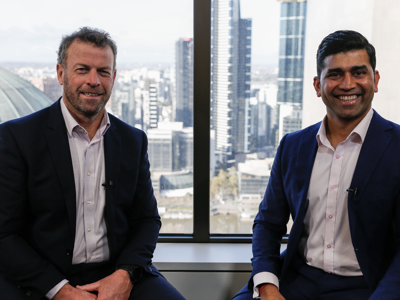I was fortunate to participate in the recent Financial Standard Best of Breed Global Research & Investment Program with industry peers from across Australia. During this two-week blitz, we met with 17 fund managers – with most showcasing multiple capabilities in the one session.
Importantly, these deep dive sessions afforded us the ability to meet with key decision makers, analysts, and senior leadership to review, probe and challenge their investment philosophy and process.
Having access to such a broad swathe of international investment experts who do not typically travel to Australia, equips participants with unique global insights to enhance local investment decision-making. Notably, the experience fosters rigorous analysis and peer collaboration across a wide spectrum of asset classes – both public and private - which ultimately strengthens our portfolio construction.

Opening Pandora’s box
Given how content-rich these two weeks in the trenches were, I’ve distilled the learnings down into key themes which repeatedly surfaced.
The first theme is that the industry’s appetite for private markets remains ravenous – a trend which Zenith has been at the forefront of over the last couple of years, with a plethora of new managers looking to be rated.
We met with multiple private markets managers offering diverse capabilities in private equity, credit and infrastructure – yet the one constant was the emphasis on the opportunities within the ‘secondaries’ space. This is because, traditionally, closed-ended private markets funds will have a lifespan of 10-years or longer, where investors’ capital is locked up.
Therefore, ‘secondaries’ are a way of providing liquidity to investors who need to exit their investment prior to the fund’s official end date – albeit are typically forced to sell at a discount to the carrying value of their investment. Consequently, the buyers of these ‘secondaries’ can access high-quality investments at a discount due to the cost of liquidity for the seller.
The secondaries surge
Whilst we’ve seen significant growth in private equity ‘secondaries’, the next evolution in retail offerings in Australia is in private credit and infrastructure which are more nascent. The concept of secondaries is highly appealing because it allows buyers to harvest a return premium - effectively a ‘free kick’ on the discount - without taking on additional underlying risk. And given our current focus on launching the Zenith Private Assets Portfolio, these meetings were instrumental in both validating and refining our thought processes for the portfolio construction.
A significant focus for these meetings was understanding how liquidity is provided monthly for a fundamentally illiquid asset class. Similarly, an ongoing point of contention was the valuation processes and methodologies, and the approach to re-valuing the secondaries purchased at a discount.
More broadly, this highlighted the importance of high-quality research when trying to navigate the complexities of any private markets offering.
Drop it like it’s hot
The other hot thematic was AI, and although the degree of incorporation into the various businesses differed vastly, most asset managers are embracing it in some form. The more sophisticated fund managers have developed their own in-house GPTs which have replaced the likes of ChatGPT.
These were incredible systems which leverage all of their internal documents and external information too. An interesting use case involved trading being outsourced to AI – although I can’t see this being incorporated into our trading processes in the near-term.
This theme built on a broader drive to gain as much informational advantage as possible in a world that’s becoming increasingly interconnected - granted, seeking information arbitrage has always been at the heart of successful investing. Despite this focus, achieving any edge is becoming increasingly difficult, and asset managers are going to the nth degree to achieve any advantage.
Data is the new oil
Examples of reliance on data outside of AI investment spend involved managers leaning on external networks for proprietary information, be it through external consultants, industry experts or industry data subscriptions. The most interesting example involved a fund manager commissioning an external consultant to evaluate a company's CEO and C-suite management prior to investment. This resulted in a 100+ page document containing the granular details of these individuals’ personal and professional lives.
In a similar vein, numerous managers presented on how they identify and manage behavioural biases when investing, and the lengths they go to when attempting to mitigate those biases, including employing a ‘behavioural coach’. This helps to force decision-making when inertia would historically have set in. As these sessions highlighted, our emotions evolved for survival on the savannah, not for selecting investments!
Follow the leader
Related to the ‘herd mentality’ bias in the investor psychology sessions was the abundance of low-tracking error strategies that are coming to market, with four managers showcasing their dedicated capabilities in this space. The strategies have explicit guidelines limiting the deviations that they can take versus the benchmark, which means investors’ returns will never stray too far from that of the benchmark – both to the up- and downside.
This is the predictable outcome of a market where returns are becoming increasingly concentrated and where end-clients are becoming more fee conscious.
Shifting tides for ‘Responsible Investment’
Another interesting shift was that references to RI/ESG were notable by their absence. This contrasted starkly to my Best of Breed trip to the US three years ago, where every manager was at pains to proudly present on their RI/ESG bona fides. Perhaps managers now integrate these considerations so tightly into their security selection and portfolio construction that a specific mention has become redundant. Regardless, the couple of sessions that were relegated to the back of the presentations were instructive.
Conversely, there were talking points that every manager would predictably parrot, typically around their ‘proprietary tools’, ‘investment led mindset’, ‘commitment to continuous improvement’, ‘high performance culture, ‘deep networks’, etc. This again highlighted the value in deep-dive sessions where you could thoroughly unpack the offering and separate the style from substance – something in which our Research Team are incredibly well-versed.
The art of the deal
From a macro-economic perspective, some key themes were repeatedly raised in various meetings. These included the risks around tariffs, running hot pro-cyclical fiscal policy, tight labour markets and elevated asset prices all leading to the potential for sustained inflationary pressures. Inflation risks were being further exacerbated by deglobalisation, protectionism, increased defence spending, and politicians’ general aversion to make unpopular decisions.
On the tariff front, markets seem to have made their peace – for now. For the most part, businesses have been absorbing the pain and the pass-through to consumers has been limited. That said, more recently we’ve seen the beginnings of a bond market riot in the long-end of the curve, which is attributable to the term premia increasing and investors demanding greater compensation due to fiscal deficit concerns. The end result is either greater issuance in the short end of the curve (which is increasingly prevalent), or a potential shift to yield curve control from the Fed.
Push and pull forces
From a portfolio construction perspective, these considerations require delicate calibration given the likelihood of elevated inflation, greater volatility and increased uncertainty – particularly now that we’re ‘living in a world of wars’ as one fund manager put it.
Ultimately, navigating these complex cross-currents makes such firsthand research vital. The insights gained equip us to be better custodians of our clients' capital, building resilient portfolios prepared for whatever challenges might lie ahead.







